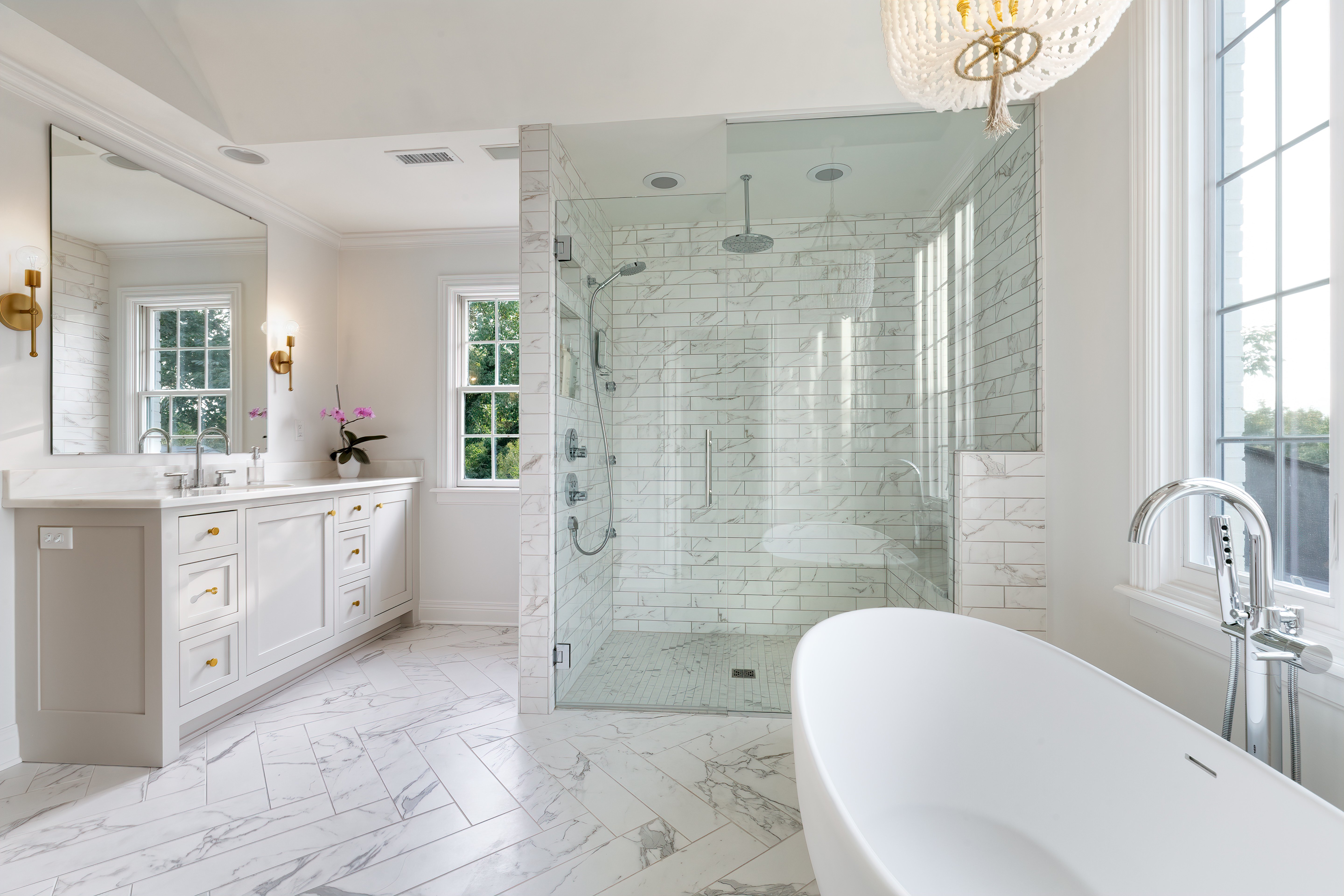
In This Article
The concept of radiant heat has come into prominence due to the comfort and quality of heat it provides to homeowners. Here's some information about what radiant heat is in general, as well as how it's used to effectively heat your home and what the many advantages are of using radiant floor heating.
What Is Radiant Heat?
Radiant heat simply refers to heat transference from a heated material or medium to another cooler material or medium through "radiation." In this context it simply means transference through a wavelength like infrared. All you have to do to see an example of radiant heating is to look up during a warm day.
That feeling of warmth from the sun—that's radiant heat.
In other words, radiant heating isn't heating the air so much as moving through the air until it's absorbed in something solid, like you. That's what heats you up. Once something has absorbed infrared waves, it begins to heat up. Then that object will begin to transfer heat to other, cooler things in the room.

Many experts say that it's a highly efficient way to make just about anything warmer, including a room.
How Radiant Heat Works
In a nutshell, radiant heat works through invisible electromagnetic waves moving through the space between you and their source, heating you up directly. Electromagnetic waves have a long spectrum, with what we call "visible light" at one part of the spectrum, but there are many more waves that we can't see on the other end.
To help make sense of this, consider the color red, which is at the higher energy part of the visible spectrum (the light we can see every day). If you keep going past the color red, you'll get into "infrared," which the human eye can no longer see. So that's why you can't see the waves that are heating you up from the sun (because they're infrared).
Once the sun emits infrared waves, they travel through space until they are stopped by an object or a person. Then the energy heats you up. If it hits an object, that heated object can then heat other things.
The energy waves can pass through air but the air isn't dense enough to absorb infrared, which is why it continues until it does hit a dense enough object.
In addition to the sun, radiant heat can be generated by any heat source like a fireplace, a stove, electric heaters, etc.
What Is Radiant Floor Heating?
A popular and specific application of the concept of radiant heat is when you use these principles to heat floors and homes.

Instead of heating air (a form of convection heating) like many other systems, radiant heating systems transfer heat to the solid objects in a room through the use of heating elements. So when comparing radiant heat vs convection heat, radiant heat is a more direct and efficient way of providing heat to a home through infrared than by relying on forced air heating.
Radiant floor heating entails installing heating elements beneath a floor which then radiates heat upwards into a room where it warms the solid objects directly. This is a much more energy efficient system and is typically accomplished by using one of two of the following mediums to generate the heat beneath the floor.
Liquid: This is also sometimes called "hydronic." This uses liquid to contain the heat and it's one of the most often used options because it's highly cost-efficient for operation (though costly to install and maintain). These floors use water heated directly from a boiler to pump right into tubing that's installed under a floor. Many of these systems have complicated systems of tubes so that you can choose to heat (or not heat) various parts of the floors in different rooms.
Electric: Another popular kind of radiant system is electric radiant floors. In this case, instead of liquid tubes, you add electric cables under the floor that heat up from electrical resistance. Electricity is more costly to operate on a per sq. ft. basis but this can be largely negated by using a programmable thermostat which will cut down on wasted energy as it only turns the heating system on when needed. Installing electric floor heating is cheaper than hydronic and there's essentially no maintenance required. Additionally, it's much easier to incorporate electric floor heating into a remodel as it doesn't require the costly retrofitting of a home to fit the pumps and boilers that hydronic systems require.
Flooring Materials
Many radiant systems are designed to be used with specific floor covering materials. For example, some are actually embedded in concrete (for finished concrete floors that are popular in basements and buildings with an industrial design aesthetic) but many heating systems are designed to be installed beneath the floor covering but above the subfloor.
The most common material to use with floor heating is ceramic tile. There are several reasons for its popularity such as the fact that it conducts heat effectively, it's usually pretty chilly if left unheated, and it's a common flooring material in areas where people are most frequently barefoot like the bathroom.

Other popular flooring materials include carpeting, linoleum, wood, or vinyl-based floor coverings, but keep in mind that if any flooring material has too high of a degree of insulation, it will impact the effectiveness of your heating system.
Advantages of Radiant Floor Heating
Radiant floor heating has a significant number of advantages. Here are a few examples of how radiant flooring wins out over other heating methods in several categories.
Durability: Electric radiant heating floor systems last a long time with almost no maintenance ever required (hydronic radiant heating systems will require some degree of maintenance). Many of these systems come with guarantees that span multiple decades.
Ease-of-Use: The systems often run themselves, more or less, after you set them up with the correct control. They can be paired with thermostats to monitor and shift temperatures as needed. There are also programmable thermostats that can be set up based on a homeowner's schedule.
Efficiency: Radiant floor heating is much more efficient than other forms of heating (like forced air) because it transfers heat directly to the objects in a room instead of relying on a medium like air to transfer the heat. Additionally, the heat begins at the floor and it naturally rises upward into the room so there's no wasted energy spent trying to direct the heat (which occurs often with forced air heating).
This means that you can typically keep your floor heating system set to an ambient temperature that is several degrees cooler than you would for a forced air system without experiencing any loss of comfort.
Even Heat: Another related advantage here, especially over forced-air systems, is that you get more evenly distributed heat throughout the room. When it comes to vent-based heating, you often have parts of a room that are much colder than others just based on how far away they happen to be from the vents.
Instead, radiant heat systems are heating the whole floor evenly so that you get an ambient temperature that's the same. In other words, there are fewer cold spots with radiant heated floors.

Free from Allergies: Since these systems are mostly heating people and objects directly instead of the air itself, it doesn't move the particles in the air as much. This means fewer pollutants ending up in your eyes or nose. Forced air systems are notorious for causing allergy problems for this reason because they are distributing allergy-causing particles everywhere while blowing around hot air.
Hassle-free Installation: Radiant heating is relatively easy for most professionals (or handy DIYers to install) but we also do offer a radiant floor heating installation service and even a remote installation supervision service.
Quieter: Radiant heating for floors is essentially silent. This is because there's no furnace that's churning all the time or that makes a loud noise when it turns on. Instead, you hear just about nothing when a radiant heat system is working.
Summing Up
Radiant heat is especially advantageous compared to traditional heating approaches like through radiators or forced air. You'll end up saving money through efficiency that will be seen in your energy bills. You'll have more particle-free air. You'll spend almost no time worrying about anything breaking down or doing maintenance on the system.
Find out more about radiant heated floors by visiting our electric floor heating page and contacting us. The sooner you contact us, the sooner we can get started helping you look into getting your own system so that you can start reaping the benefits of radiant heat for yourself.
Have Questions About Your Project?
Our team of Radiant Experts is ready to help!
Stay Updated
Get the latest radiant heating news and tips delivered to your inbox.


